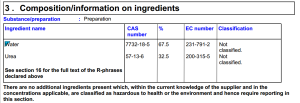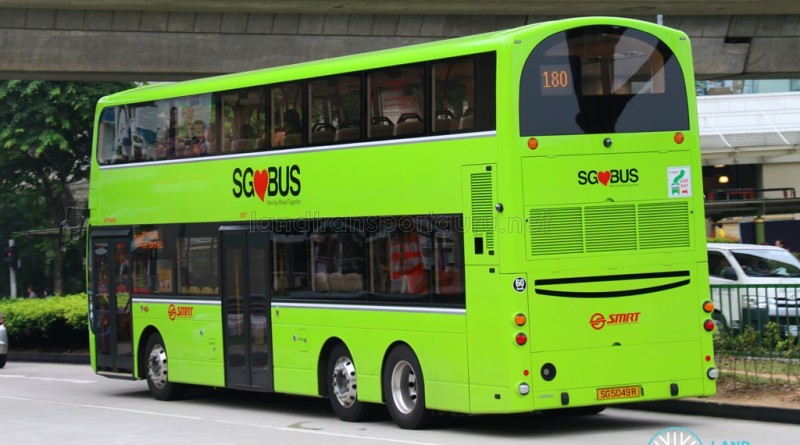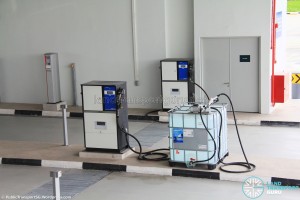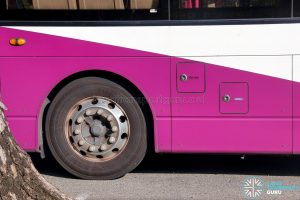Introduction:
Selective Catalytic Reduction, or SCR, is one of two nitrogen oxide (NOx) emissions reduction technique used in diesel engines, the other being Exhaust Gas Recirculation (EGR). It involves the conversion of nitrogen oxides (NOx) into atmospheric nitrogen and water vapour through using diesel exhaust fluids as a catalyst.
SCR technology is utilized in several bus models in Singapore to achieve the Euro IV and Euro V emissions standards. These models include:
- Alexander Dennis Enviro500
- Mercedes-Benz Citaro
- Mercedes-Benz OC500LE
- Volvo B9TL (excluding CDGE)
- Volvo B7RLE
Among Euro V buses, SCR is the dominant method of emissions control given with large numbers of Mercedes-Benz Citaro and Volvo B9TL buses in the public transport fleet.
Euro VI buses
How it works:
The main concept behind SCR is converting harmful NOx emissions into nitrogen and water vapour. The system requires diesel exhaust fluids, or DEFs as the reacting agent. Ammonia and urea can both be used.
AdBlue is the commercial name for the most commonly used form of DEF, and is essentially a 32.5% high-purity urea solution diluted in deionized water. In this article, AdBlue will be used commonly to describe DEF. Here’s how an SCR system works:

- Step 1: Air and diesel are combusted in the engine. Hot exhaust gases are channelled out of the engine as indicated by red arrows.
- Step 2: Exhaust gases pass through a first catalyst chamber. Diesel exhaust fluid (AdBlue) is stored in an onboard tank and then sprayed into the exhaust channel. The pump regulates the amount of AdBlue added in response to engine output.
- Step 3: AdBlue fully reacts with the exhaust gases within the second and main catalyst chamber, indicated as SCR catalysor in the diagram. Exhaust gas is then discharged.
The science behind SCR:
SCR achieves Euro IV and V emission standards by adhering to lower hydrocarbon (HC), lower nitrogen oxide (NOx) and lower particulate matter (PM) levels in the exhaust gas. Of these three, NOx is a byproduct of high-temperature combustion and cannot be reduced through clean combustion alone. SCR chemically removes NOx by converting it into nitrogen and water vapour.
SCR relies on diesel exhaust fluids such as AdBlue, an aqueous urea solution with the chemical formula (NH2)2CO. It reacts with NOx present in exhaust gases as represented in the following overall equation:
4NO + 2(NH2)2CO + O2 → 4N2 + 4H2O + 2CO2
The optimum temperature for this reaction so happens to be similar to that of exhaust gas from the engine. However, the reaction requires a catalyst to complete the chemical reaction more efficiently. As such, a catalyst chamber is used. The cayalyst chamber is constructed of various precious metals, whose surfaces act as heterogeneous catalysts to aid the completion of the reaction. At the end, relatively less harmful gaseous products (nitrogen gas, carbon dioxide and water vapor) are discharged from the exhaust with minimal NOx content; approximately 85% of NOx is removed with the system.
A more thorough representation of the chemical reactions behind SCR is summarized in the following diagram:

In this diagram, the mechanism behind the two-stage catalytic chamber design is more clearly illustrated. The first chamber is an oxidation catalyst chamber which removes HCs and PMs. The second chamber has three parts. The first hydrolysis catalyst breaks down the urea into ammonia and carbon dioxide. The second SCR catalyst is where the major reactions take place, converting NOx into nitrogen gas and water vapor. The third and final oxidation catalyst reacts any remaining ammonia into nitrogen gas and water vapor.
AdBlue:

The diesel exhaust fluid AdBlue is critical to all SCR systems in vehicles. It contains 32.5% high-purity urea for direct injection into vehicle exhaust systems. Urea is generally safe and non-toxic, however it can corrode some metals and must be transported with care. AdBlue delivery systems are generally well-equipped to deal with the corrosive properties of the liquid.
Due to the prevalence of AdBlue buses in Singapore, Public Transport Operators have AdBlue pumps in their major bus depots. Since AdBlue is consumed between 2-6% of diesel consumption volume (or approximately 1.5 liters per 100 kilometers), AdBlue tanks need not be refilled as often as diesel. Purchased in bulk, AdBlue is affordable and sustainable in the long run.
Product Names:
Different vehicle manufacturers have their own product names for their exhaust aftertreatment systems, and these systems often incorporate SCR technology, especially for Euro VI diesel engines and above.
One of the most well-known SCR system is BlueTec, which was introduced to European market by DaimlerChrysler in early 2005 as the first commercial urea-based SCR system. It relies primarily on SCR technology and combines a diesel particulate filter and other NOx reducing systems. The BlueTec branding carries on to this day, where all Euro V Mercedes-Benz Citaro buses in Singapore incorporate the BlueTec 5 emissions control system.
The Pros and Cons of SCR:
A. The Pros:
- Simplicity of design
SCR is relatively straightforward in concept and does not require the use of excess regulatory components as seen in EGR systems. - Cleaner combustion engine
Unlike EGR, SCR does not interfere with the combustion process within the engine. The result is cleaner combustion, delivering more power, better fuel economy, lower service intervals and greater longevity. Less strain on engine cooling systems also result in a quieter engine and radiator. - Sustainable in the long run
SCR technology can keep up with rising emission standards easily by optimizing the ratio of AdBlue and catalytic environments.
B. The Cons:
- AdBlue required for emissions
SCR systems are optimized for running with AdBlue. Running without AdBlue will violate emissions standards and may cause damage to catalytic components in the long run. The cost of purchasing AdBlue is an additional factor in the profitability of bus operations. - Availability of AdBlue
Over long distances, AdBlue must be topped up regularly. However, the increasingly widespread use of AdBlue makes it easier to travel around without stocking up on AdBlue. Bus operators in Singapore purchase AdBlue in bulk and have their own pumps within bus depots.
Despite the traditional EGR-SCR rivalry in the race for cleaner emissions, newer Euro VI-compliant diesel engines incorporate both EGR and SCR technology to meet the stringent requirements. Diesel-electric hybrid technology makes Euro VI possible without the incorporation of EGR.
Gallery:
External Links & References:
- Selective Catalytic Reduction – Wikipedia
- Diesel Exhaust Fluid – Wikipedia
- Information – Handling Adblue
- Pros & Cons of EGR and SCR – Fleetowner.com
- EGR versus SCR – AdBlue online
- AdBlue: The Facts – DAF
- BlueTec Emissions – Detriot Diesel
Back to Bus Services
Back to Bus Articles





